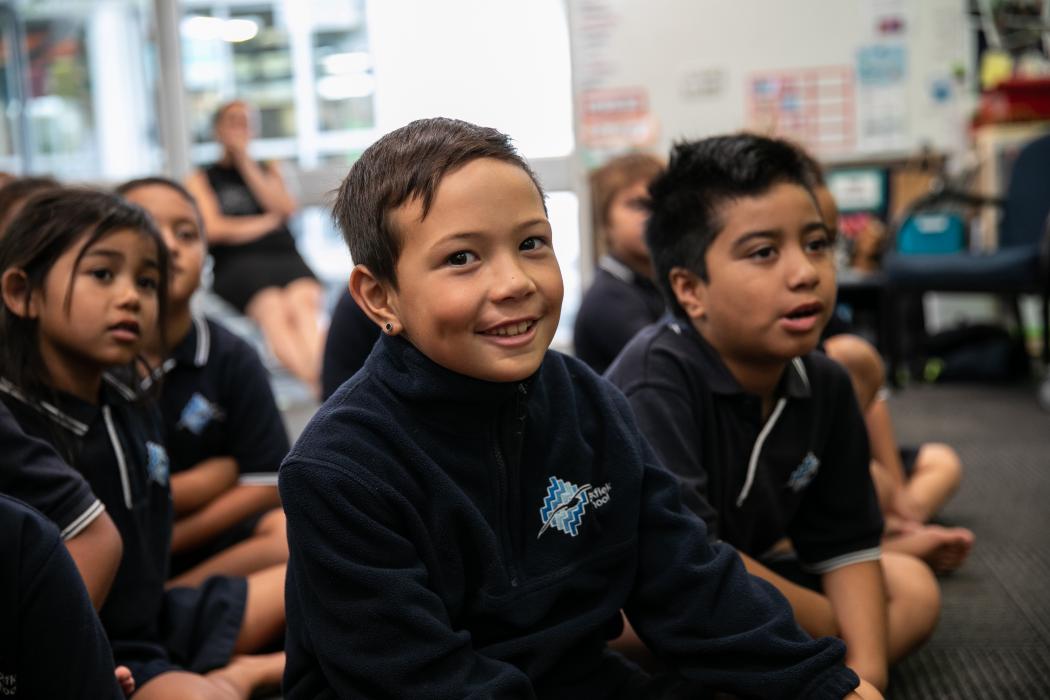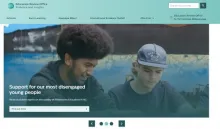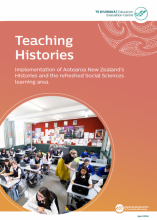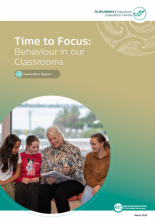(We open on an aerial shot of a long road, with dense forestry on either side. A man’s voice speaks in voice-over and as he says ‘ensure’ the camera changes to an aerial shot of a school. After briefly panning over the school as several children play below, the scene changes to inside a classroom where a woman plays guitar as a group of young children and adults watch. As the voice-over mentions the different types of learning services we briefly see a group of younger children playing, primary-aged children riding bikes, older students performing a haka and children wearing backpacks walking to school.)
VOICE-OVER: Te Tari Arotake Mātauranga the Education Review Office works to ensure all New Zealanders can have confidence in our early learning services, kōhanga reo, kura, wharekura and schools.
(A trio of women holding documents walk through a school. A group of children excitedly run through a school gate. We then see a classroom where students are working intently.)
VOICE-OVER: We work in partnership with education providers to ensure every place is a great place to learn.
(The camera pans across the grounds of the New Zealand Parliament Buildings.)
VOICE-OVER: ERO is a government agency.
(The ERO logo appears at the top of the screen and text appears below reading, “Reviews, independently review the quality of education and help education providers improve”. In the background we can faintly see a series of classroom scenes.)
VOICE-OVER: It’s our job to independently review the quality of education our children receive, and to help education providers improve.
(We briefly see another classroom scene where a woman sits at a small table with several students before the camera changes to a busy schoolyard. As the voiceover says ‘community’ the scene briefly changes to a pōwhiri, a student attaching a peg to a string, then a pair of young children in a classroom with a tablet computer.)
VOICE-OVER: As part of reviews, we work to understand each school’s unique qualities - its community, culture, strengths and needs of learners.
(A group of adults sit around a table in a school library, looking over documents and discussing something amongst themselves.)
VOICE-OVER: We give feedback and guidance to improve and strengthen systems, plans and teaching practices.
(The ERO logo returns to the top of the screen and text appears reading, “Research, To find solutions to the most difficult challenges in our education system”. In the background we can faintly see scenes of students walking to school.)
VOICE-OVER: We also undertake research to find solutions to the most difficult challenges in our education system.
(The scene changes to a room where a group of adults sit in a circle discussing something. We see plates of food and someone pours tea from a kettle. As the voice-over says ‘publish’ the ERO logo once again appears at the top of the screen and we see a faded-out scene of two women looking at a computer. One points to the screen and text appears reading, “ero.govt.nz”.)
VOICE-OVER: We want parents, whānau, families and the wider community to have access to the information they need, so we publish our reports and research online.
(The screen now changes to the homepage of ERO’s website. A cursor moves across the page to click on a link, then scrolls across a list of learning facilities.)
VOICE-OVER: Our reports help parents and whānau make decisions about what school, kōhanga reo, kura or early learning service is right for their child.
(We now see a close-up of a hand-written poster in te reo. Someone points at the text, and the camera zooms out to show a man speaking to a class of students as he gestures towards the poster.)
VOICE-OVER: At ERO, we believe in embracing te reo Māori and in education that meets the aspirations parents and whānau have for their tamariki.
(We briefly see a crowd of students in backpacks walk through a school, a classroom where students learn on laptops, a crowd of students in uniforms, then teacher sitting with students in a classroom.)
VOICE-OVER: All of Aotearoa New Zealand’s children and young people have the right to high quality education.
(We return to the aerial shot of the school from earlier in the video. The camera pans away from the school as below a group of student chase after it. Finally, we see the ERO logo and the url for ERO’s website, ero.govt.nz.)
VOICE-OVER: You can find more information here on our website, ero.govt.nz.



